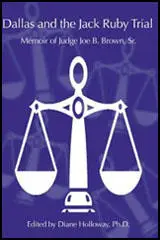Joe Tonahill

Joe H. Tonahill was born in 1914. He attended the University of Texas before becoming a lawyer in Jasper, Texas. A former wrestler, Tonahill was six feet four and weighed over 300 pounds. His father-in-law, was Howard W. Smith, a right-wing congressman from Virginia, who had played an important role in blocking legislation instigated by John F. Kennedy.
In November, 1963, he was employed by Jack Ruby as his attorney and worked with Melvin Belli on defending him against the charge of murdering Lee Harvey Oswald. It was Tonahill who arranged for Dorothy Kilgallen to have a private meeting with Ruby. According to Tonahill, Kilgallen had a closer relationship with Ruby than other writers who attended the trail.
Tonahill also told Seth Kantor that "Ruby could have been used" by others to kill Oswald. He added: "It wouldn't have been any problem to reach in and get Ruby to do something like this, through the power of suggestion, through innuendo, without Ruby even realizing it." Tonahill also believed that the Dallas Police Department was involved in this conspiracy: "the police had to be in on it because of the strange coincidence in the timing of their arrivals - first Ruby; then Oswald soon after."
Primary Sources
(1) Seth Kantor, Who was Jack Ruby? (1978)
Joe Tonahill, one of Ruby's lawyers, is convinced that "Ruby could have been used" by others to kill Oswald. "It wouldn't have been any problem to reach in and get Ruby to do something like this, through the power of suggestion, through innuendo, without Ruby even realizing it. The conversation with Olsen and Kay could have been the beginning of it.
It could have been a lot stronger. We don't know who all he talked with."
Tonahill expresses the strong possibility that Ruby's conversation with the police officer was much more explicit. "Ruby didn't want to talk about that conversation because he had enough sense to know that was premeditation," Tonahill says of Ruby's skill in keeping the fact that there even had been a dark encounter with Olsen secret until after Ruby's trial was over.
(2) Lee Israel, Kilgallen (1979)
During one of her (Kilgallen’s) visits - sometime in March, before the verdict – she prevailed upon Joe Tonahill to make arrangements through Judge Brown for a private interview with Jack Ruby.
Brown, awestruck by Dorothy, acceded readily to Tonahill’s request. The meeting room in the jailhouse was bugged, and Tonahill suspected that Brown’s chambers were as well. Brown and Tonahill chose a small office off the courtroom behind the judge’s bench. They asked Ruby’s ubiquitous flank of four sheriff’s guards to consent to remain outside the room.
Dorothy was standing by the room during a noon recess. Ruby appeared with Tonahill. The three entered the room and closed the door. The defendant and Dorothy stood facing each other, spoke of their mutual friend, and indicated that they wanted to be left alone. Tonahill withdrew. They were together privately for about eight minutes, in what may have been the only safe house Ruby had occupied since his arrest.
Dorothy would mention the fact of the interview to close friends, but never the substance. Not once, in her prolific published writings, did she so much as refer to the private interview. Whatever notes she took during her time alone with Jack Ruby in the small office off the judge’s bench were included in a file she began to assemble on the assassination of John F. Kennedy.
